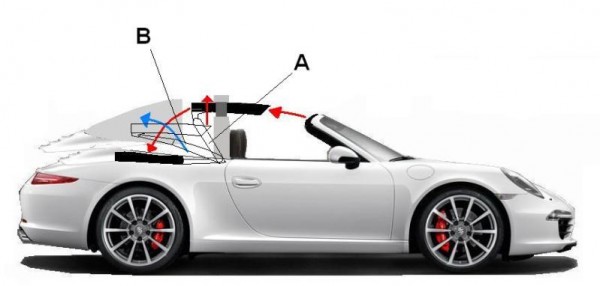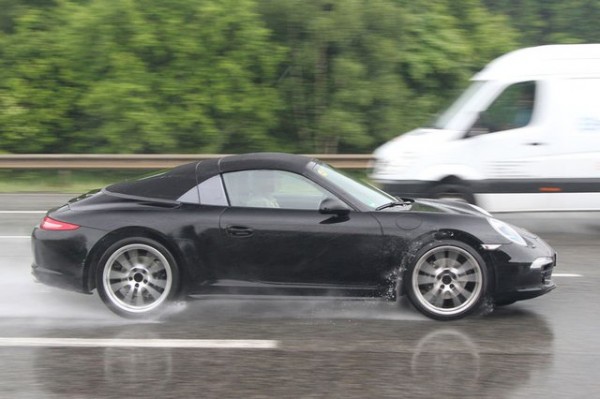UPDATE: This Is How The New Porsche 911 Targa Roof Operates
For a little while now, we’ve been seeing prototypes and hearing rumors about the new 991 Targa and the fact that it’s bringing back the full width roof opening not seen since the 964 generation. This sounded less than optimal to some, as the primary reason for converting to a retractable glass roof in the 993 was electrical operation convenience. How would Porsche justify selling a car that required the owner to fiddle with a removable top again?
The answer, we think, is that they won’t. The 991 Targa mechanism will likely incorporate a fully automatic roof retraction system, combined with the return of the awesome old-school-cool aluminum trim Targa bar. A member of the Rennlist forum created the image above to depict how he imagines Porsche would engineer this solution. His vision sees Porsche using a similar Z-frame and hydraulically actuated clam-shell system to the existing Cabriolet.
The 991 Cabriolet uses a fully enclosed clam-shell to cover the convertible top when it it stowed, and according to this patent filing, it will operate similarly on the new Targa. Bringing back the full width curved rear glass, however, mounts a problem. The Targa would potentially need to lift the rear glass section, in addition to the clam-shell, to hide the targa top when not in place. Using hydraulic actuators, the rear section could lift up, while a Z-frame scissor section would lower the targa top section down under the rear section.
Continuing the trend of the 997, leaked Porsche documents have stated that the 991 Targa will only be available in all wheel drive configurations, based on the widebody Carrera 4 and Carrera 4S.
For those interested in sifting through the legal jargon, an excerpt from the patent application is added after the related posts.
Other Porsche Blog Posts You Will Enjoy
What Do You Think These Leaked Patent Images From Porsche Show?
Meet the World’s Tallest Porsche Enthusiast
Porsche Police Car
The invention claimed is:
1. A roof construction of a motor vehicle having an upper cowl of a windshield and a convertible-top compartment, the roof construction comprising:
a fixed roll bar;
an opening and closing mechanism;
a roof element which, in a closed position, is accommodated in front of said fixed roll bar, namely between said fixed roll bar and the upper cowl of the windshield, and, in an open position, is accommodated behind said fixed roll bar in the convertible-top compartment and which can be shifted from the open position into the closed position and vice versa from the closed position into the open position beyond said fixed roll bar via said opening and closing mechanism; and
a covering having a transverse part and side parts for covering said fixed roll bar on an outside in the open position of said roof element and in the closed position of said roof element, said side parts of said covering extending substantially in a vertical direction, can be shifted at least partially, or at least in sections, relative to said fixed roll bar during a shifting of said roof element from the open position into the closed position and vice versa from the closed position into the open position, said transverse part of said covering extending generally in a horizontal direction, being fastened to said fixed roll bar so as not to be able to be shifted relative thereto,
wherein said side parts of said covering include curved transition sections and can be shifted completely to said transverse part of said covering, and relative to said fixed roll bar during the shifting of said roof element from the open position into the closed position and vice versa from the closed position into the open position, and wherein only said curved transition sections of said side parts of said covering can be shifted to said transverse part and relative to said fixed roll bar during the shifting of said roof element from the open position into the closed position and vice versa from the closed position into the open position.
2. The roof construction according to claim 1, wherein said side parts, including said curved transition sections, are fastened to a convertible-top compartment cover of the convertible-top compartment and can be shifted relative to said fixed roll bar via said convertible-top compartment cover during the shifting of said roof element.
3. The roof construction according to claim 2, wherein said side parts, including said curved transition sections, are fastened to the convertible-top compartment cover so as not to be able to be shifted relative thereto.
4. The roof construction according to claim 1, wherein only said curved transition sections are fastened to a convertible-top compartment cover of the convertible-top compartment and can be shifted relative to said roll bar via the convertible-top compartment cover during the shifting of said roof element.
5. The roof construction according to claim 4, wherein only said curved transition sections are fastened to the convertible-top compartment cover so as not to be able to be shifted relative thereto, whereas remaining sections of said side parts of said covering together with said transverse part of said covering are fastened to said fixed roll bar so as not to be able to be shifted relative thereto.
6. The roof construction according to claim 1, wherein said curved transition sections are fastened to said fixed roll bar so as to be able to be shifted relative thereto, whereas remaining sections of said side parts of said covering together with said transverse part of said covering are fastened to said fixed roll bar so as not to be able to be shifted relative thereto.
7. The roof construction according to claim 6, further comprising a shifting mechanism, said curved transition sections are coupled to said fixed roll bar via said shifting mechanism and can be shifted relative to said fixed roll bar.
8. The roof construction according to claim 7, wherein:
said opening and closing mechanism has a drive; and
said shifting mechanism for said curved transition sections is coupled to said opening and closing mechanism of said roof element and can be actuated via said drive of said opening and closing mechanism.
9. The roof construction according to claim 7, wherein said shifting mechanism for said curved transition sections is assigned a separate drive for actuating said shifting mechanism.

